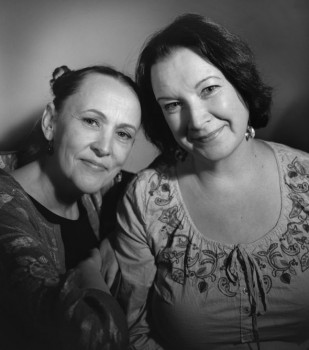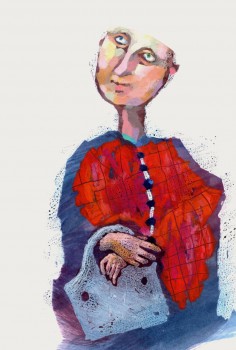Journeys to nearby places
18 April 2013 | Authors, Interviews

Workmates: Virpi Talvitie and Katri Tapola. Photo: Teos
Short texts and vibrant illustrations merge composing capricious situations in Katri Tapola and Virpi Talvitie’s adult picture book. Mahdollisuuksien rajoissa. Matkakirja (‘In the realm of impossibility. Travel book’, Teos, 2013) turns the ordinary pleasantly askew
It is a different kind of travel book: instead of faraway places, it explores things nearby, where our gaze and our thoughts don’t usually pause – the little things at the bottom of a pocket, in a dark closet full of outdoor gear, quiet moments in noontime traffic.
The travellers are perhaps Nobody in Particular, or somebody called Random. We keep on travelling, but we don’t get any farther than the corner store. What’s small becomes large, what’s supposedly large shrinks. Our self-image is off-kilter, there’s a hole in our CV, and the world is pleasantly tilted.
A-L E: The book is in the form of short prose – a page, half a page. What was it like to write these compact texts?
K T: I love having constraints; the short form is very rewarding. Focus and compactness make your whole life clear. And this has been good for me to learn because I’m naturally prone to long, extended forms of expression.
A-L E: Your first collaborative short prose work, Ihmetyksiä – Tarinoita ja kuvia hämmästyneille (‘Wonders: Stories and pictures for the bewildered’, Tammi), which appeared six years ago, was similar in theme and tone to Mahdottomuuksien rajoissa. How did you come to look at the world differently from the way we usually do?
K T: The books had their origins in pain and poverty. At the time of the first book, I had an injured leg, but was still able to walk, slowly. That’s how it started. At the time of this second book, I was poor. I would put my hand in the pocket of my old quilted jacket hoping to find a coin and find something quite different… and that something eventually became the thread of the book.
A-L E: So they have a fairly solid foundation in reality?
K T: Yes, they do. All the stories are actually things that happened to me – although of course I did condense and polish and focus them in the writing process. I believe that we all have these encounters and collisions with small objects and things like that. A writer’s job can be to take up these kinds of things as subjects for writing.
A-L E: Your stories convey a warm, forgiving attitude. For instance the story ‘Calendar cleansing’ makes me think about how real the hurry that gnaws away at almost everything actually is. When you start to consciously look at your calendar, not many truly unavoidable items are written there.
K T: Exactly. It’s a question of focus. Stopping time. Of course, I’m really not a besserwisser who knows how to cleanse my own calendar as well as in the story! But you can at least try to turn your attention in that direction. It’s nice to look at things differently and tilt your gaze or turn it inside out. When you change your point of view, many things change their shape. A small thing can become large and idleness can get the respect it deserves.

An open mind? Illustration: Virpi Talvitie
A-L E: You’ve given the stories a large dose of humour, as well.
K T: Humour yes, but no irony. Humour is important because it brings us together, gives us some relief. I think that there is more that unites people than divides them.
A-L E: Virpi, how did you come up with the illustrations for Katri’s texts?
V T: When I do these books with Katri, we discuss them extensively, usually by email. That way we have a record of our thoughts, ideas, and words and they might even end up in the book. The words and the image click into place and the shared world is easy to find because we’ve created a shared world of expression where we hang out and marvel at things, work and discuss, encourage each other, egg each other on. This shared world is a sort of mental space where there’s a lot of mutual understanding, trust and humour. It’s very fertile and inspiring, a wild but also safe place to do bold creative work.
A-L E: How do you see the role of illustration in these picture books for adults?
V T: I think that the pictures in these books don’t ‘illustrate’ or ‘accompany’ the text, but carry on a dialogue with the texts.
A-L E: When did your literary collaboration begin?
V T: About ten years ago. In addition to these adult picture books we’ve done five children’s books together. We were born in the same year (1961) and are from Ilmajoki in Ostrobothnia, but we were only distantly acquainted in childhood. Our shared environment growing up has certainly given us plenty to draw on as adults.
A-L E: What techniques did you use in the illustrations?
V T: A mixed technique that I developed myself, using a specific type of strong, thick oil pastels, water-colour that pearls up on the surface and in the folds, and patterns and details scratched into the surface with a blade. The colours are important to me. So are the juxtapositions and layers, both pictorially and symbolically.
A-L E: Are there more of adult picture books that marvel at the world in the works?
K T: Absolutely. It’s too tempting not to. You have to do something else between projects, but yes, we’ve already got a third book largely conceived. Its working title is Välitilassa – opas tuulikaappiin ja takaisin (‘In-between places: a traveller’s guide to the vestibule and back again’). In-between space interests me. After all, our whole life is an in-between place, for all of us – between birth and death. And the best stories are conceived ex tempore – in chance encounters in vestibules and places like that.
Translated by Lola Rogers
Tags: illustration, writing
No comments for this entry yet
Leave a comment
Also by Anna-Leena Ekroos
The princess who quit - 27 February 2014
The party's not yet over - 14 November 2013
Movies and mores - 16 April 2012
Fools and devils - 30 June 2007
-
About the writer
Anna-Leena Ekroos (born 1968) is a freelance journalist and critic living in Vaasa.
© Writers and translators. Anyone wishing to make use of material published on this website should apply to the Editors.
